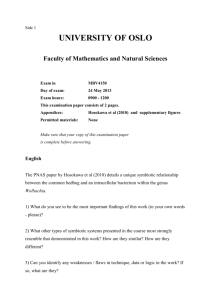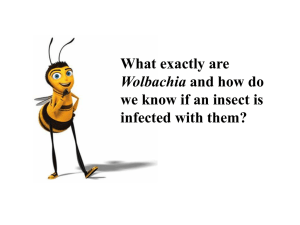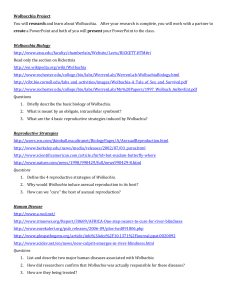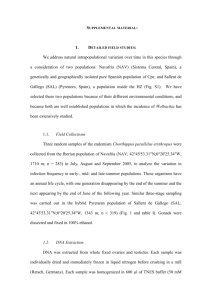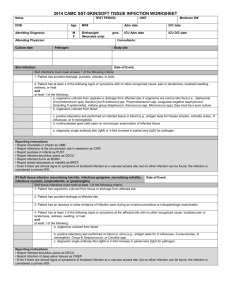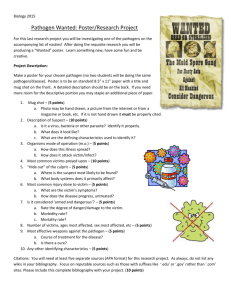Survey of the Wolbachis spp. Infection Rate in the Flea Species
advertisement
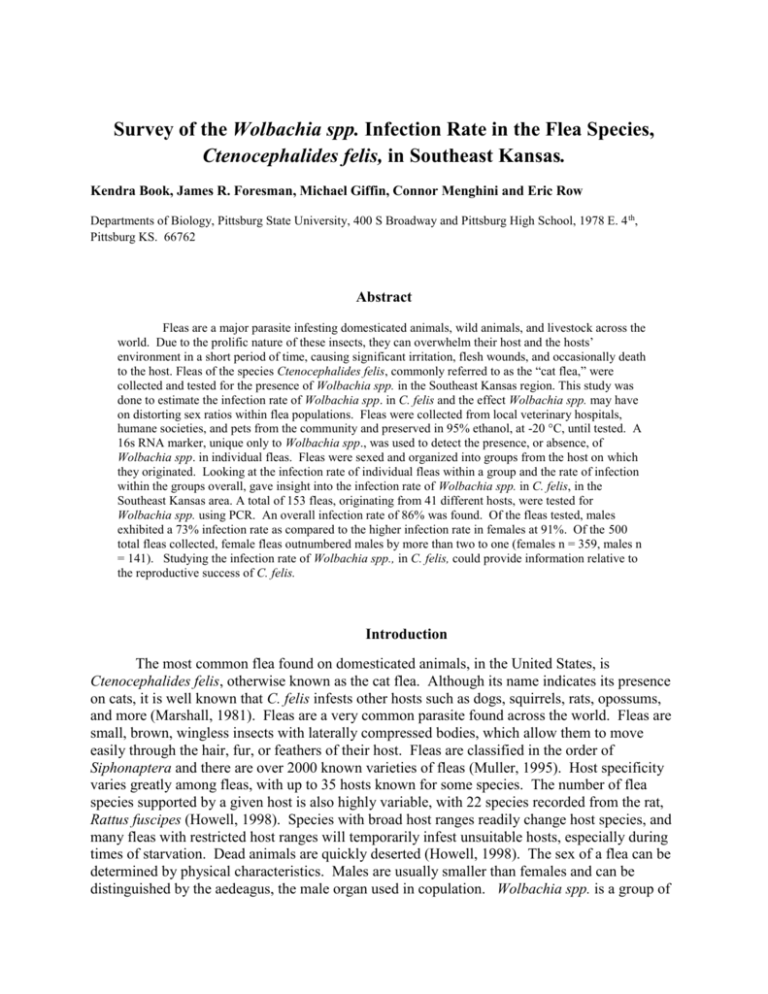
Survey of the Wolbachia spp. Infection Rate in the Flea Species, Ctenocephalides felis, in Southeast Kansas. Kendra Book, James R. Foresman, Michael Giffin, Connor Menghini and Eric Row Departments of Biology, Pittsburg State University, 400 S Broadway and Pittsburg High School, 1978 E. 4 th, Pittsburg KS. 66762 Abstract Fleas are a major parasite infesting domesticated animals, wild animals, and livestock across the world. Due to the prolific nature of these insects, they can overwhelm their host and the hosts’ environment in a short period of time, causing significant irritation, flesh wounds, and occasionally death to the host. Fleas of the species Ctenocephalides felis, commonly referred to as the “cat flea,” were collected and tested for the presence of Wolbachia spp. in the Southeast Kansas region. This study was done to estimate the infection rate of Wolbachia spp. in C. felis and the effect Wolbachia spp. may have on distorting sex ratios within flea populations. Fleas were collected from local veterinary hospitals, humane societies, and pets from the community and preserved in 95% ethanol, at -20 °C, until tested. A 16s RNA marker, unique only to Wolbachia spp., was used to detect the presence, or absence, of Wolbachia spp. in individual fleas. Fleas were sexed and organized into groups from the host on which they originated. Looking at the infection rate of individual fleas within a group and the rate of infection within the groups overall, gave insight into the infection rate of Wolbachia spp. in C. felis, in the Southeast Kansas area. A total of 153 fleas, originating from 41 different hosts, were tested for Wolbachia spp. using PCR. An overall infection rate of 86% was found. Of the fleas tested, males exhibited a 73% infection rate as compared to the higher infection rate in females at 91%. Of the 500 total fleas collected, female fleas outnumbered males by more than two to one (females n = 359, males n = 141). Studying the infection rate of Wolbachia spp., in C. felis, could provide information relative to the reproductive success of C. felis. Introduction The most common flea found on domesticated animals, in the United States, is Ctenocephalides felis, otherwise known as the cat flea. Although its name indicates its presence on cats, it is well known that C. felis infests other hosts such as dogs, squirrels, rats, opossums, and more (Marshall, 1981). Fleas are a very common parasite found across the world. Fleas are small, brown, wingless insects with laterally compressed bodies, which allow them to move easily through the hair, fur, or feathers of their host. Fleas are classified in the order of Siphonaptera and there are over 2000 known varieties of fleas (Muller, 1995). Host specificity varies greatly among fleas, with up to 35 hosts known for some species. The number of flea species supported by a given host is also highly variable, with 22 species recorded from the rat, Rattus fuscipes (Howell, 1998). Species with broad host ranges readily change host species, and many fleas with restricted host ranges will temporarily infest unsuitable hosts, especially during times of starvation. Dead animals are quickly deserted (Howell, 1998). The sex of a flea can be determined by physical characteristics. Males are usually smaller than females and can be distinguished by the aedeagus, the male organ used in copulation. Wolbachia spp. is a group of intracellular bacteria found in Arthropods and Nematodes that has been proven to effect their reproduction. This effect can be facultative, mutualistic, or even deleterious. Typically the association is facultative, but straddles the boundary been facultative and deleterious (Mercot, 2009). Wolbachia spp. will attempt to manipulate its host in order to ensure its own transmission. Wolbachia spp. is transmitted vertically from female to offspring, and therefore favors the survival of females over males; males can be viewed as a genetic dead-end for Wolbachia spp. (O’Neill, Hoffmann, and Werren). Four mechanisms of vertical transmission have been described, three of which are detrimental to the non-transmitting sex (i.e. the males): male killing, feminization, and thelytokus parthenogenesis induction. The fourth mode of transmission is cytoplasmic incompatability (CI). CI reduces the transmission of cytoplasmic lineages by females that are either not infected or infected by a different Wolbachia spp. as the male that fertilizes their eggs (Mercot, 2009). While many species of Arthropods and Nematodes have been studied for Wolbachia’s effects on their reproduction, much research is still needed to show just what effect Wolbachia spp. has on each of its hosts. Studies thus far indicate that Wolbachia’s effect and infection rate is not the same in every species. Some species such as those in the Nematodes are dependent on Wolbachia spp. for survival, as supported when removal of Wolbachia spp. with antibiotics results in sterility or even death of the worm (Mercot, 2009). Parasitic insects such as fleas and mosquitoes are of great interest concerning their relationship with Wolbachia spp. due to the impact the specific Wolbachia spp. host has on disease transmission in various geographical areas of the world. The purpose of our research is two-fold; to determine the Wolbachia spp. infection rate in C. felis from samples taken in S.E. Kansas and to collect data regarding the effect Wolbachia spp. may have on sex ratios in C. felis. Materials and Methods Collection and DNA Isolation Fleas were collected from host dogs (Canis familiaris) and cats (Felis domesticus) within Crawford County, Kansas. The locations of collection included Broadway Animal Hospital, Langdon Lane Animal Hospital, Country Side Animal Hospital, Town and Country Animal Hospital, Southeast Kansas Humane Society and from individual households. The methodology of collection ensured a relatively diverse range of locations from which the fleas originated. Fleas collected from an individual animal were placed in a separate vial containing a 95% ethanol solution and stored at -20ºC. Fleas were categorized into groups based on the host from which they were collected. This allowed the survey to take into consideration the infection rate within each group, or colony, of fleas found on each host; as well as the overall infection rate. Every group was labeled by the date they were collected, the host from which they came, the severity of the infestation, and the veterinary hospital collected from, when it applied. Therefore a group collected on July 7 from a dog with a severe infection would read as follows: 7-7DH. If that same group were collected at a veterinary hospital (Broadway Animal Hospital) it would read: 7-7DBAH. Table 1 Hospital Name Broadway Animal Hospital Langdon Lane Animal Hospital Countryside Animal Hospital Town and Country Animal Hospital Acronym BA LL CS TC Host Name Dog Cat D C Severity of Infection High Medium Low H M L In the laboratory, fleas were further identified by species (C. felis) and sex. Fleas were individually ground in a 0.9% NaCl solution by manual or mechanical means (a power drill with the pestle inserted as a drill bit) until it was obvious the flea had been emaciated. To this, 100 µl of chelex was added and the sample boiled at 99ºC in a thermal cycler (Hybaid Omn-E Thermal cycler) for 10 minutes. Following boiling, the samples were spun in a microcentrifuge for 10 minutes at 14,000rpm. 5 µl of supernatant (DNA) was added to a 0.5ml Ready-To-Go™ PCR bead and primers in preparation for PCR. Polymerase Chain Reaction and cloning Detection of Wolbachia spp. was demonstrated by amplifying a 438bp fragment of the 16S ribosomal RNA gene that is ubiquitous in Wolbachia spp. These primers were WSPEC-F (5’CATACCTATTCGAAGGGATAG-3’) and WSPEC-R (5’- AGCTTCGAGTGAAACCAATTC3’). Positive control Primers were also used to amplify a 658 bp fragment of the CO1 cytochrome oxidase gene that is ubiquitous in arthropod mitochondria. These primers were LCO1490 (5’- GGTCAACAAATCATAAAGATATTGG-3’) and HCO2198 (5’TAAACTTCAGGGTGACCAAAAAATCA-3’). Postive control included a Wolabachia spp. infected Nasonia vitripennis (+), Drosophila melanogaster (+) and Wolbachia spp. DNA (+). Negative control was a non-Wolbachia spp. infected Nasonia vitripennis (-). The thermal cycler was programmed for the optimal settings as follows: 1 cycle – 2 minutes @ 94ºC, 30 cycles – 30 seconds @ 94ºC, 45 seconds @ 55ºC and 1 minute @ 72ºC. 1 cycle – 10 minutes @ 72ºC. Isolated PCR products were observed using a 2% agarose gel electrophoresis run at 110V for 25 minutes in a 1% TAE Bufffer (Promega Cat. #V4281). 10µl of 5mg/ml ethidium bromide was added to 1 L 1% TAE running buffer in the preparation of the agarose gel as our fluorescent tag. Positive Wolbachia spp. PCR products were prepared for sequencing using QIAquick PCR purification kit (Qiagen, USA). Sequences were determined on an ABI 3730XL using Wolbachia spp. specific 16S rRna primers to initiate DNA synthesis in BigDye cycle-sequencing reactions (Life Technologies Corp., Carlsbad, CA). The nucleotide sequences were assembled into individual contigs using the software package Sequencher (http://www.genecodes.com) Data Analysis and Positive Conformation Verification of Wolbachia spp. positive samples was accomplished by viewing the finished gels under ultraviolet light. A 100bp ladder run in a separate lane within each gel gave a reference point to Wolbachia spp. positive samples as well as the cytochrome oxidase gene. The 438bp Wolbachia spp. amplicon, which was evidence of a positive Wolbachia spp. sample, migrated further than the 658bp cytochrome oxidase amplicon. Positive Wolbachia spp. revealed two DNA bands in each lane. See figure 1. Figure 1 Each lane (excluding the DNA ladder) represents an individual flea or insect control allowing positive/negative conformation of Wolbachia spp. in each flea within a sample group. Initially more fleas from individual groups were run to assess the infection rate within each group. As the data continued to reveal each group to have a high infection rate, the sampling technique was changed to allow more groups to be tested resulting in fewer individual fleas from each group being tested. Our goal changed from looking at infection rates within each group to looking at the overall infection rate within the local area. Because groups initially testing positive had tendencies to have relatively high infection rates within the group, any group testing positive was assumed to have a similarly high infection rate. Results The results of the study showed a Wolbachia spp. positive infection rate in every group of fleas tested. A total of 500 fleas were collected in this project with the ratio of females to males counted greater than two to one. 72% (n=359) were female and 28% (n=141) were male. A total of 41 groups were collected and 153 fleas were tested for the presence/absence of Wolbachia spp. The percentage of positive infection within each group varied from 33% to 100%. Overall infection rate was 86% of all fleas tested. 45 males tested positive with a 73% infection rate, while 108 females tested positive with a 91% infection rate. See appendix 1 for the complete collection spreadsheet. Total Tested Total Males Tested Total Females Tested 153 45 108 Total Positive Total Positive Males Total Positive Females 131 33 % Positive 86% 73% 98 91% Total Groups 41 100% Total Collected 500 Total Males 141 Total Females 359 % males 28% % females 72% Positive Wolbachia spp. samples were sent to the Marine Biological Laboratory for sequencing of the amplified product from the 16s rDNA gene. 46 total samples were sequenced. The amplified sequences ranged from 102bp to 321bp with the greatest percentage of products over 300bp. The results of sequencing verified the presence of a Wolbachia spp. super clade. The use of a clustal W sequence alignment tool demonstrated no DNA variation within the 46 samples sequenced with the exception of one sample. When the sequence of this outlier was blasted to the database on NCBI, it confirmed the sequencing of the amplified product to that of the CO1 gene, not the amplified product of the 16s rDNA gene. Discussion Our investigation establishes a high rate of Wolbachia spp. infection in the flea species C. felis within Southeastern Kansas. Our study expands the available knowledge of a 21% infection rate (Gorham, 2003) on the east coast, to an 86% infection rate in the Midwest. It is unknown why the infection rate varied so drastically from Gorham’s study to our own. A high Wolbachia spp. infection rate along with a high female to male ratio could provide insight into the relationship between C. felis and Wolbachia spp. As a part of their lifestyle as reproductive parasites, Wolbachia spp. demonstrate a wide variety of strategies for manipulating its hosts into producing higher proportions of infected female offspring. Females are favored over males because males are considered reproductive dead ends. Wolbachia spp. is only transmitted to future generations through the cytoplasm of the egg, but not the sperm. Therefore, in theory, higher ratios of Wolbachia spp. infected females will lead to increased transmission of Wolbachia spp. to future generations (Koehncke A, Telschow A, Werren J.H, Hammerstein P [2009]). However, the fact that there was only moderate difference between the infection rate in males and females suggests that no male killing effect is present. If male killing were to take place in C. felis it is unlikely that we would find such a high number of infected males. In addition, the high ratio of females to males is expected in temporary parasites, where the males often have shorter life spans and are more active. This results in a greater separation from the host, as opposed to females (Marshall, 1981). Females require a continuous supply of blood, from the host, to continue egg production; therefore females must stay with the host (Dryden, 1989). However, some colonies of C. felis are reported to have high ratios of females, immediately following pupal development. Two colonies studied, in vitro, revealed a 59.8% and 58.2% female ratio following pupae emergence. In addition, female fleas started emerging from the pupae around 8 days (after pupae development), 4 days early than males who began emerging at 12 days. By the 13th day, all viable females had emerged while males were just beginning to emerge. Males finished emerging from the pupae around the 17th day. Interestingly the two colonies reported a 60.0% and 66.0% emergence rate of adult fleas from the egg (Dryden, 1988). Perhaps Wolbachia spp. offers a fitness advantage to those fleas that are infected. It would be interesting to test the eggs in which fleas had not emerged against the emerged adult fleas to see if there was a significant difference of Wolbachia spp. infection. Egg production by C. felis varies considerably under various environmental conditions. Temperature and humidity are the two biggest contributing factors in flea egg development (Dryden, 1989). Past data current to 2009 does not show significant differences of average temperature and humidity between Georgia and Kansas. However, it is possible that temperature, humidity, and even topography are playing a role in the varying Wolbachia spp. infection in colonies from different regions. Annual rainfall does differ slightly from the Counties in Georgia (where Gorham’s’ testing was done) to Southeast Kansas. Southeastern Georgia (where Bulloch, Liberty, and Chatham Counties are located) receives an average of 4650 inches a year. Southeast Kansas receives closer to 40 inches on average (Oregon Climate Service [OCS] and National Resource Conservation Service [NRCS]). It is easy to speculate that the intricate relationship that these insects have with their environment could play a role in the insect’s ability to maintain a Wolbachia spp. infection. Wolbachia spp., after all, can be a costly organism for some species to maintain. Wolbachia spp. either increases or decreases the fitness of an organism, and this relationship can change overtime (O’Neil, Hoffman, and Werren). It is therefore possible that the fitness cost of Wolbachia spp. on C. felis may vary from one region to another. C. felis colonies in other parts of the country may have reduced their infection rates due to Wolbachia’s influence; this could explain the difference in prevalence rates from one area to another. Gorham collected fleas from four counties: three in Georgia and one in New York (the majority of fleas coming from the three counties in Georgia). Gorham noted a difference between the infection rates in fleas collected from wild animals as opposed to domestic animals in Bulloch County Georgia. 79 total fleas were collected from the area, 43 of those coming from one opossum. Gorham also collected fleas from 1 cotton rat and numerous western gray squirrels. If prevalence rates are compared between domestic and wild animals, in Bulloch county, the domestic rates are much higher than the wild: 43% vs. 2% respectively. Gorham did not collect fleas from wild animals in any other counties to compare rates with. The rest of his fleas, from the three other counties, were all collected from domestic animals and did not show infection rates as high as from Bulloch County. The average infection rate from the three other counties was 33% (Gorham 2003). All of the fleas collected for our experiment came from domestic animals. Perhaps C. felis is less productive in the wild due to limited host availability. This would result in less mating and fewer chances to pass on Wolbachia spp. from one generation to the next. Animals in the wild would also be more mobile and less likely to dwell in the same place as long as domestic animals. This would only allow fleas developing on the host (as opposed to developing in the environment near the host) to stay with the colony; potentially limiting colony populations and Wolbachia spp. transmission. The relative confinement of domestic animals could confer an advantage to the transmission of Wolbachia spp. positive fleas by restricting the distribution area of the eggs in the environment. A conclusion that can be drawn from our survey is that Wolbachia spp. is highly prevalent in C. felis in Southeast Kansas. Every colony of C. felis tested positive to some degree for Wolbachia spp. infection. This leads us to believe that Wolbachia spp. may be endemic to C. felis in this area. Further studies are needed to tell what role Wolbachia spp. may play in manipulating the reproductive abilities of C. felis. The amount of research on Wolbachia spp. prevalence in the Siphonaptera order is very limited. Further investigations into the prevalence rates of Wolbachia spp. in other flea species are needed. Literature Cited Dryden, M. W. and M. K. Rust. The cat fleabiology, ecology and control. Vet. Parasitol 52:1–19. 1994. Dryden M. Host Association, On Host Longevity and Egg Production of Ctenocephalides felis. Vet. Parasitol. 34:117-122, 1989. Dryden, Michael W. Evaluation of Certain Perameters in the Bionomics of Ctenocephalides Felis Felis (Bouche 1835). Thesis. Purdue University, 1988. Marshall, Adrian G. The Ecology of Ectoparasitic Insects. London: Academic, 1981. Mercot, Herve, and Denis Poinsot. "Infection by Wolbachia: from passengers to residents." ScienceDirect (2009): 284-297. Web. 21 Sep 2009. Muller, George. H, Danny W. Scott. Small Animal Dermatology. 4th Edition. Philadelphia: W.B. Saunders Company, 1995. Silverman, J. and M. K. Rust. Influence of temperature and humidity on the survival and development of the cat flea, Ctenocephalides felis (Siphonaptera: Pulicidae). J. Med. Entomol 18:78–83. 1981. O'Neill, Scott L., Ary A. Hoffmann, and John H. Werren. Influential Passengers: Inherited Microorganisms and Arthropod Reproduction. Oxford [England: Oxford UP, 1997. Print. Oregon Climate Service (OCS) and National Resource Conservation Service. PRISM Precipitation Maps: 1961-90. http://www.wrcc.dri.edu/precip.html. Koehncke, Arnulf, Arndt Telschow, John H. Werren, and Peter Hamerstein. "Life and Death of an Influential Passenger: Wolbachia and the Evolution of CI-Modifiers by Their Hosts." PLoS ONE E4425 4.2 (2009). Print. Riguad, T. (1997). “Inherited Microorganisms and Sex Determination of Arthropod Hosts,” in Influential Passengers (ed. S. O’Neil, A.A. Hoffman & J.W. Werren) pp. 81-101. Kageyama D. and Traut W. Opposite sex-specific effects of Wolbachia and Interference with the sex determination of its host Ostrinia scapulalis. Laboratory of Applied Entomology, University of Tokyo, 113-8657, Japan.
